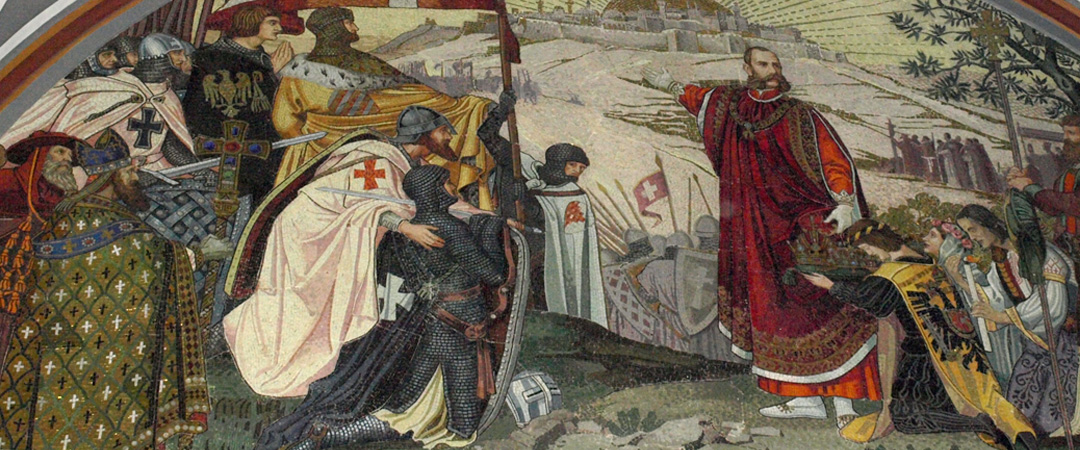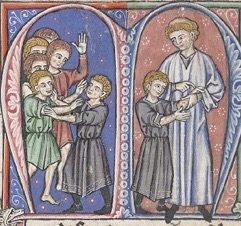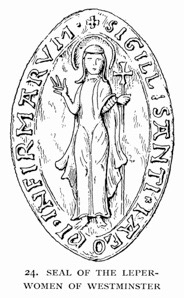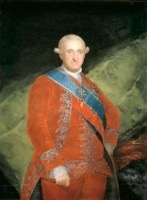History of the Order

Hospitaller Origins
The hospitaller origins of the Order can be traced to the 4th century when a hospice was established outside the walls of Jerusalem by a group of monks under the rule of St. Basil. Its particular mission was the care and treatment of lepers and those suffering from skin diseases. Later, the Order had a brief but very useful role in exterminating leprosy in Europe during the Crusades in the Middle Ages, another brief naval period when it served with distinction attacking pirates in the Mediterranean during the seventeenth century, after which it became an honorific distinction bestowed by the King of France.
Five major orders were organised in the Holy Land in the late 11th to early 12th century:
Knights Templar,
Knights Hospitaller (St. John),
Knights of the Holy Sepulchre,
Knights of the Hospital of St. Mary of Jerusalem (Teutonic Knights) and
Knights of Saint Lazarus
Templar knights who contracted leprosy were sent to the care of the Order of Saint Lazarus. These knights trained the brethren of Saint Lazarus in the military arts and were responsible for transforming the Order into a military one. The first bull in their favor is dated 15 February 1113 and refers to "Gerard, Founder and Governor of the Hospital at Jerusalem and his Legitimate Successors".

William, Archbishop of Tyre (1130-1186), as well as other historians of the period, appeared unaware of the difference between the Orders of Saint Lazarus and Saint John, referring to them both in their accounts only as "Hospitallers". Some believe that the Order of St. Lazarus took on a separate identity from 1120 when Boyand Roger, Rector of the Hospital of Jerusalem was elected Master of the Hospitallers of Saint Lazarus. In 1154, Louis VII, on his return from the Second Crusade, gave the Order the Château of Boigny, near Orléans. The first written reference we have to Saint Lazarus as a "knightly" order is a letter written by Henry II, King of England and Duke of Normandy, dated 1159, in which he makes a large donation to it, and refers to the "Knights and Brethren of Saint Lazarus".
By 1256 the Order of St. Lazarus had grown considerably and its existence was recognized by Pope Alexander IV under the Rule of St. Augustine. It acquired a church, a convent and a mill in Jerusalem and property near the Mount of Olives. It built a chapel at Tiberias and two hospitals for pilgrims in Armenia. It acquired more establishments at Nablus, Ascalon and Cæsarea.
In England and Scotland

The Order first appeared in England during the reign of King Stephen (1135-1154). Through the efforts of Sir Roger de Mowbray, a Royal Charter was granted by King Henry II to a hospital that had been established at Burton in Leicestershire in 1177. The hospital at Burton Lazars, as it was later called, became the chief house of the Order in England. It was administered by a Master as well as eight knights, and was under the protection of the Blessed Virgin and Saint Lazarus. In succeeding years, many hospitals and commanderies were erected in England and, at one period, the Order possessed as many as 95 Leper Houses throughout the kingdom before it was suppressed by Henry VIII in 1544 (Page, 1954).
In Scotland, the Order acquired considerable prestige under Robert the Bruce. A commandery was founded by Royal Charter, issued by Alexander II (1214-49) and administered from Linlithgow, where it had its headquarters. Lazar Houses were founded in various parts of the kingdom (Marcombe, 2004).
In Ireland
The Knights Hospitallers were introduced to Ireland with the Norman invasion. They were first established at Wexford around 1172 and the Priory at Kilmainham was established in Dublin around 1174 by Strongbow, Richard de Clare, Earl of Pembroke. In 1212 Pope Innocent III confirmed some 129 properties acquired by the Order in Ireland although the number of knights was quite small (30-40) due to the fact that a candidate had to have proof of nobility, pay a large fee, maintain himself and 2 horses, travel on call and when they died all their property and possessions was to be bequeathed to the Order.
In Ireland as elsewhere the brethren had to maintain their primary duty to provide hospitality to pilgrims and travellers, but because of the ongoing rebellion by the Irish Clans in the wake of the Norman invasion the preceptories very often acted as military outposts on the borders of the Anglo-Norman territories such as at Killybeggs and Kilteel in Co. Kildare (Corrigan, 2006). It is unclear if any of the hospitallers who came to Ireland between the 12th and 16th centuries belonged to the Order of St. Lazarus (Gwynn and Hadcock, 1970, p. 344) although it would seem most probable that some of the leper houses in Ireland belonged to the Order (Lee, 1996, p. 9). Certainly, many locations today bear names which indicate an earlier connection with hospitallers and the care of lepers. These include Palmerstown (pilgrims town) and Lazar’s Hill, both in Dublin.
The last Prior of Kilmainham was Sir John Rawson, appointed in 1511. With the advent of the suppression of the monasteries and religious houses Rawson negotiated the surrender of Kilmainham and the properties of the Order in 1540. After about 365 years this marked the end of the Hospitaller Knights at Kilmainham (Lennox-Barrow, 1985).
Post Reformation
By the early sixteenth century the Order was moribund. Leprosy had been virtually eliminated in Europe. The Crusades were over, and in Papal eyes there was very little to justify the continued existence of the Order of Saint Lazarus. Though the knights of St. Lazarus at Boigny continued to function as an order, as far as the Pope was concerned, the Order in France had ceased to exist.

On 25 July 1593, King Henry of Navarre abjured the Protestant faith in order to accede to the French throne as Henri IV.
In 1608, two years before his assassination, he amalgamated two orders, which then became known as the Order of Our Lady of Mount Carmel and Saint Lazarus. The insignia of the new order was an eight-pointed Maltese cross bearing fleurs de lys in the angles and quartered of the colors of both orders (purple and green) bearing on the obverse a representation of Our Lady and on the reverse of Saint Lazarus. Historians of the Order claim that, although they owed allegiance to a common grand master, neither order lost its sovereign identity.
In theory the Order was military, but with the exception of a brief period in the 17th century when it manned ten naval frigates it played no military role after it left the Holy Land. It was composed of diplomats, high-level civil servants and members of the titled nobility and was limited to 100 knights. The King was the sovereign head and protector and chose the Grand Master. Although the Order enjoyed a unique relationship with the French Royal House and was officially under the protection of the King of France, it was never a Royal Order. The King's titles as Sovereign, Founder and Protector meant that he was Sovereign and Founder of Our Lady of Mount Carmel and Protector of Saint Lazarus.
During the French Revolution a decree of 30 July 1791 suppressed all royal and knightly orders. Another decree the following year confiscated all the Order's properties. Louis, Count of Provence, Grand Master of the Order, who later became Louis XVIII, continued to function in exile and awarded the Order, though sparingly. Shortly after Louis acceded to the throne in 1814, Napoleon escaped from Elba and returned to France, forcing the King to leave Paris again to seek refuge in Ghent. During this period and after he returned to France, circumstances did not permit the King to summon a Chapter General to elect a Grand Master. The Order was governed by a Lieutenant-General, the Duc de Châtre, assisted by M. Silvestre, the Herald, M. Dacier, the historiographer, and Father Picot, a chaplain from Versailles.
King Louis XVIII, the Protector, and the Duc de Châtre both died in 1824. King Charles X succeeded his brother and took the title of Protector, and left the Order to be governed by a Council of Officers, headed by the Marquis d'Autichamps, and the Council of (hereditary) Commanders. Recruitment slowly resumed and promotions were made. In 1830 Charles X abdicated, and with his de jure successor, the young Duc de Bordeaux, who reigned from 2 to 7 August 1830 as Henri V, went into exile. King Henri V was the last de jure royal Protector of the Order. The Order did not enjoy the protection of the new king and was not listed thereafter in the royal Almanac. From 1830 the Order of St. Lazarus was governed by a Council of Officers. The knights and hospitallers of the Order felt it was necessary for the Order to have a Protector and in 1841 Patriarch Maximos III Malzoum who had for years been acquainted with the Order of St Lazarus agreed that he and his successors would become Spiritual Protectors of the Order.
The Knights Hospitaller resumed activities in Ireland in 1903 when a division of the St. John’s Ambulance Brigade was established by Sir John Lumsden at St. James’ Gate in Dublin. Later, the Order of Malta was re-established in 1934 and on 21st September 1962 the Military and Hospitaller Order of St. Lazarus of Jerusalem was inaugurated as the Bailiwick of Ireland at Dunsany Castle. On that occasion the Rt. Hon. Randal Plunkett Lord Dunsany was invested as Chancellor of the Order in Ireland. The Irish jurisdiction was later raised to the status of a Grand Priory and the Hereditary Commandery of Fanad was also instituted.

Grand Bailiffs of Ireland
Chevalier Randal Plunkett, Lord Dunsany 1962 - 1970
Chevalier Denis O’Conor Don, Prince of Connacht 1970 - 1995
Grand Priors of Ireland
Chevalier Paddy Faloon 1995 - 1997
Chevalier John Kerry-Keane 1997 - 2003
Chevalier Bernard Barton S.C. 2003 - 2017
Chevalier Conor Keoghan 2018 -
The Order continues to operate in Ireland and throughout the world as an ecumenical Order of Chivalry. In 2008, His Excellency, Don Carlos Gereda de Borbon, Marquis de Almazan, a direct descendent of King Charles IV of Spain, was elected as the 49th Grand Master of the Order.
Sources:
Babcock, E.A. and Krey, A.C. 1943. trans. Introduction to William of Tyre, A History of Deeds Done Beyond the Sea. Columbia University Press.
Page, W. 1954. The Victoria history of the county of Leicester, Volume 2:a. Constable.
Marcombe, D. 2004. Leper Knights: The Order of St. Lazarus of Jerusalem in England. Boydell Press.
Corrigan, M. 2006. Church of the Oak. Kildare: Grey Abbey Conservation Project.
Gwynn, A. and Hadcock, R.N. 1970. Medieval Religious Houses, Ireland. London.
Lee, G. 1996. Leper Hospitals in Medieval Times. Dublin: Four Court Press.
Lennox-Barrow, G. 1985. The Knights Hospitaller of St. John of Jerusalem at Kilmainham. Dublin Historical Record. Vol. 38:3. pp. 108-112.
For a more complete account of the Order’s history please consult the international website.
The hospitaller origins of the Order can be traced to the 4th century when a hospice was established outside the walls of Jerusalem by a group of monks under the rule of St. Basil. Its particular mission was the care and treatment of lepers and those suffering from skin diseases. Later, the Order had a brief but very useful role in exterminating leprosy in Europe during the Crusades in the Middle Ages, another brief naval period when it served with distinction attacking pirates in the Mediterranean during the seventeenth century, after which it became an honorific distinction bestowed by the King of France.
Five major orders were organised in the Holy Land in the late 11th to early 12th century:
Knights Templar,
Knights Hospitaller (St. John),
Knights of the Holy Sepulchre,
Knights of the Hospital of St. Mary of Jerusalem (Teutonic Knights) and
Knights of Saint Lazarus
Templar knights who contracted leprosy were sent to the care of the Order of Saint Lazarus. These knights trained the brethren of Saint Lazarus in the military arts and were responsible for transforming the Order into a military one. The first bull in their favor is dated 15 February 1113 and refers to "Gerard, Founder and Governor of the Hospital at Jerusalem and his Legitimate Successors".

William, Archbishop of Tyre (1130-1186), as well as other historians of the period, appeared unaware of the difference between the Orders of Saint Lazarus and Saint John, referring to them both in their accounts only as "Hospitallers". Some believe that the Order of St. Lazarus took on a separate identity from 1120 when Boyand Roger, Rector of the Hospital of Jerusalem was elected Master of the Hospitallers of Saint Lazarus. In 1154, Louis VII, on his return from the Second Crusade, gave the Order the Château of Boigny, near Orléans. The first written reference we have to Saint Lazarus as a "knightly" order is a letter written by Henry II, King of England and Duke of Normandy, dated 1159, in which he makes a large donation to it, and refers to the "Knights and Brethren of Saint Lazarus".
By 1256 the Order of St. Lazarus had grown considerably and its existence was recognized by Pope Alexander IV under the Rule of St. Augustine. It acquired a church, a convent and a mill in Jerusalem and property near the Mount of Olives. It built a chapel at Tiberias and two hospitals for pilgrims in Armenia. It acquired more establishments at Nablus, Ascalon and Cæsarea.
In England and Scotland

The Order first appeared in England during the reign of King Stephen (1135-1154). Through the efforts of Sir Roger de Mowbray, a Royal Charter was granted by King Henry II to a hospital that had been established at Burton in Leicestershire in 1177. The hospital at Burton Lazars, as it was later called, became the chief house of the Order in England. It was administered by a Master as well as eight knights, and was under the protection of the Blessed Virgin and Saint Lazarus. In succeeding years, many hospitals and commanderies were erected in England and, at one period, the Order possessed as many as 95 Leper Houses throughout the kingdom before it was suppressed by Henry VIII in 1544 (Page, 1954).
In Scotland, the Order acquired considerable prestige under Robert the Bruce. A commandery was founded by Royal Charter, issued by Alexander II (1214-49) and administered from Linlithgow, where it had its headquarters. Lazar Houses were founded in various parts of the kingdom (Marcombe, 2004).
In Ireland
The Knights Hospitallers were introduced to Ireland with the Norman invasion. They were first established at Wexford around 1172 and the Priory at Kilmainham was established in Dublin around 1174 by Strongbow, Richard de Clare, Earl of Pembroke. In 1212 Pope Innocent III confirmed some 129 properties acquired by the Order in Ireland although the number of knights was quite small (30-40) due to the fact that a candidate had to have proof of nobility, pay a large fee, maintain himself and 2 horses, travel on call and when they died all their property and possessions was to be bequeathed to the Order.
In Ireland as elsewhere the brethren had to maintain their primary duty to provide hospitality to pilgrims and travellers, but because of the ongoing rebellion by the Irish Clans in the wake of the Norman invasion the preceptories very often acted as military outposts on the borders of the Anglo-Norman territories such as at Killybeggs and Kilteel in Co. Kildare (Corrigan, 2006). It is unclear if any of the hospitallers who came to Ireland between the 12th and 16th centuries belonged to the Order of St. Lazarus (Gwynn and Hadcock, 1970, p. 344) although it would seem most probable that some of the leper houses in Ireland belonged to the Order (Lee, 1996, p. 9). Certainly, many locations today bear names which indicate an earlier connection with hospitallers and the care of lepers. These include Palmerstown (pilgrims town) and Lazar’s Hill, both in Dublin.
The last Prior of Kilmainham was Sir John Rawson, appointed in 1511. With the advent of the suppression of the monasteries and religious houses Rawson negotiated the surrender of Kilmainham and the properties of the Order in 1540. After about 365 years this marked the end of the Hospitaller Knights at Kilmainham (Lennox-Barrow, 1985).
Post Reformation
By the early sixteenth century the Order was moribund. Leprosy had been virtually eliminated in Europe. The Crusades were over, and in Papal eyes there was very little to justify the continued existence of the Order of Saint Lazarus. Though the knights of St. Lazarus at Boigny continued to function as an order, as far as the Pope was concerned, the Order in France had ceased to exist.

On 25 July 1593, King Henry of Navarre abjured the Protestant faith in order to accede to the French throne as Henri IV.
In 1608, two years before his assassination, he amalgamated two orders, which then became known as the Order of Our Lady of Mount Carmel and Saint Lazarus. The insignia of the new order was an eight-pointed Maltese cross bearing fleurs de lys in the angles and quartered of the colors of both orders (purple and green) bearing on the obverse a representation of Our Lady and on the reverse of Saint Lazarus. Historians of the Order claim that, although they owed allegiance to a common grand master, neither order lost its sovereign identity.
In theory the Order was military, but with the exception of a brief period in the 17th century when it manned ten naval frigates it played no military role after it left the Holy Land. It was composed of diplomats, high-level civil servants and members of the titled nobility and was limited to 100 knights. The King was the sovereign head and protector and chose the Grand Master. Although the Order enjoyed a unique relationship with the French Royal House and was officially under the protection of the King of France, it was never a Royal Order. The King's titles as Sovereign, Founder and Protector meant that he was Sovereign and Founder of Our Lady of Mount Carmel and Protector of Saint Lazarus.
During the French Revolution a decree of 30 July 1791 suppressed all royal and knightly orders. Another decree the following year confiscated all the Order's properties. Louis, Count of Provence, Grand Master of the Order, who later became Louis XVIII, continued to function in exile and awarded the Order, though sparingly. Shortly after Louis acceded to the throne in 1814, Napoleon escaped from Elba and returned to France, forcing the King to leave Paris again to seek refuge in Ghent. During this period and after he returned to France, circumstances did not permit the King to summon a Chapter General to elect a Grand Master. The Order was governed by a Lieutenant-General, the Duc de Châtre, assisted by M. Silvestre, the Herald, M. Dacier, the historiographer, and Father Picot, a chaplain from Versailles.
King Louis XVIII, the Protector, and the Duc de Châtre both died in 1824. King Charles X succeeded his brother and took the title of Protector, and left the Order to be governed by a Council of Officers, headed by the Marquis d'Autichamps, and the Council of (hereditary) Commanders. Recruitment slowly resumed and promotions were made. In 1830 Charles X abdicated, and with his de jure successor, the young Duc de Bordeaux, who reigned from 2 to 7 August 1830 as Henri V, went into exile. King Henri V was the last de jure royal Protector of the Order. The Order did not enjoy the protection of the new king and was not listed thereafter in the royal Almanac. From 1830 the Order of St. Lazarus was governed by a Council of Officers. The knights and hospitallers of the Order felt it was necessary for the Order to have a Protector and in 1841 Patriarch Maximos III Malzoum who had for years been acquainted with the Order of St Lazarus agreed that he and his successors would become Spiritual Protectors of the Order.
The Knights Hospitaller resumed activities in Ireland in 1903 when a division of the St. John’s Ambulance Brigade was established by Sir John Lumsden at St. James’ Gate in Dublin. Later, the Order of Malta was re-established in 1934 and on 21st September 1962 the Military and Hospitaller Order of St. Lazarus of Jerusalem was inaugurated as the Bailiwick of Ireland at Dunsany Castle. On that occasion the Rt. Hon. Randal Plunkett Lord Dunsany was invested as Chancellor of the Order in Ireland. The Irish jurisdiction was later raised to the status of a Grand Priory and the Hereditary Commandery of Fanad was also instituted.

Grand Bailiffs of Ireland
Chevalier Randal Plunkett, Lord Dunsany 1962 - 1970
Chevalier Denis O’Conor Don, Prince of Connacht 1970 - 1995
Grand Priors of Ireland
Chevalier Paddy Faloon 1995 - 1997
Chevalier John Kerry-Keane 1997 - 2003
Chevalier Bernard Barton S.C. 2003 - 2017
Chevalier Conor Keoghan 2018 -
The Order continues to operate in Ireland and throughout the world as an ecumenical Order of Chivalry. In 2008, His Excellency, Don Carlos Gereda de Borbon, Marquis de Almazan, a direct descendent of King Charles IV of Spain, was elected as the 49th Grand Master of the Order.
Sources:
Babcock, E.A. and Krey, A.C. 1943. trans. Introduction to William of Tyre, A History of Deeds Done Beyond the Sea. Columbia University Press.
Page, W. 1954. The Victoria history of the county of Leicester, Volume 2:a. Constable.
Marcombe, D. 2004. Leper Knights: The Order of St. Lazarus of Jerusalem in England. Boydell Press.
Corrigan, M. 2006. Church of the Oak. Kildare: Grey Abbey Conservation Project.
Gwynn, A. and Hadcock, R.N. 1970. Medieval Religious Houses, Ireland. London.
Lee, G. 1996. Leper Hospitals in Medieval Times. Dublin: Four Court Press.
Lennox-Barrow, G. 1985. The Knights Hospitaller of St. John of Jerusalem at Kilmainham. Dublin Historical Record. Vol. 38:3. pp. 108-112.
For a more complete account of the Order’s history please consult the international website.

